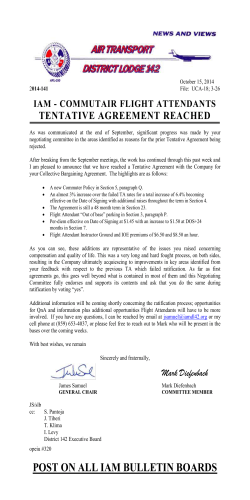
Home Care Attendant Training and Quality of Care from the
APRIL 2015 Home Care Attendant Training and Quality of Care from the Perspectives of Home Care Consumers A Center for Women and Work Research Brief Linda Houser and Mary Beth Semerod RESEARCH SUMMARY The term home care refers to the range of medical and personal care services and supports that facilitate independent living in the community. Given the increasingly central role of home-based caregiving in the lives of individuals with physical disabilities, we address a gap in the literature on home-based care by asking adult consumers of home care services to describe their experiences with home care, the training that their care providers have received, and their perceptions of the relationship between training and quality of care. To conduct this study, we partnered with a Pennsylvania home care agency. Working with this organization offered us a unique opportunity to explore the relationship between care provider training and care quality, specifically for people with physical care needs. Over the past five to six years, statelevel policy changes have altered home care services policy in multiple ways, including reductions in funding available to offset the costs of training homecare providers. In this transition, the agency, its service consumers, and staff have experienced firsthand the transition from a comprehensive training model called “Building Bridges” (80 total training hours) to a condensed model of pre-employment (3 hours) and in-service (minimum 2 hours per year) training. Two factors differentiate the comprehensive Building Bridges training from condensed training models: the intensity of the training and the involvement of care consumers in the training process. Under Building Bridges, trainings were developed and provided through the Training and Upgrading Fund of District 1199c of the National Union of Hospital and Health Care Employees (NUHHCE). The 80 hours of training brought attendants and care consumers together to learn not only the general approaches and skills involved in home-based care provision, but also the particular needs of individual consumers. Through semi-structured interviews with 20 consumers of care and 8 attendants, we explored perceptions of care quality, homecare attendant training, and the relationship between training and quality of care. Consumers and attendants identified several elements as constitutive of “quality care.” These included the following: Autonomy Mutual respect Access to resources both in their homes and in their communities Consumer-Attendant Fit Stability Attendant preparation and performance Attendant well-being Janice H. Levin Building, Suite 224 Piscataway, NJ 08854 cww.rutgers.edu Our study also uncovered both consumer and attendant views on important skills and characteristics for in-home personal care providers. Notably, we received a similar, one-word answer to these questions from both consumers and attendants: patience. For consumers, this first P – patience – was often followed by two other Ps –passion and personality. In fact, even when asked about skills attendants should have or training topics that should be covered, consumers often brought up characteristics of the individual attendant – a certain “personality.” Lastly, consumers identified an attentiveness to the job encapsulated by the expression “on point” (i.e., focused on the work). While autonomy, including the right to dismiss attendants, to interview attendants before agreeing to take them on, to establish standards for work quality, and to establish household rules, was highly prized by consumers, this appeared in stark contrast to consumers’ current lack of involvement in initial training of attendants. Indeed, feedback from consumers whose attendants received training under the Building Bridges model described above, revealed a distinct preference for this training that is both hands-on and consumer-informed. Building Bridges had allowed consumers to work alongside professional trainers to teach their attendants care techniques, both generally and in reference to their specific set of needs and preferences. Perhaps the most compelling contrast between consumers and attendants trained under Building Bridges and those trained more recently was the former’s strong recollection of training content and ability to connect the training to a current skill set. By contrast, consumers who had begun to receive services more recently knew very little about the training that had been received by their attendants. Interview evidence suggests that, while even the 3-hour training provides attendants with some useful general knowledge with which to begin, attendants lack condition-specific knowledge, as well as hands-on knowledge. In some cases, this leads to some in-home trial-and-error that may, in turn, contribute to failed consumer-attendant connections; frustration, anxiety, and shame on the part of consumers and attendants; and even a risk to consumers’ physical well-being. Homecare attendants provide services that allow people to live in their own homes and that give respite to familial care providers. The work is intimate and often prolonged. While brief, topical trainings do play a role in preparing homecare attendants, the gap between consumer and new attendant expectations seems best addressed through comprehensive consumer-informed and/or consumer-facilitated training in partnership with professional trainers. ~2~
© Copyright 2025









